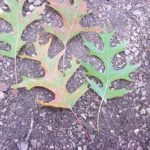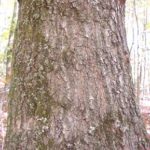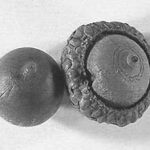scarlet oak (Quercus coccinea)
Family: Fagaceae
Categories |
Images |
|---|---|
| Form:
This is a medium sized tree reaching 60-80 ft. in height and 2-3 ft. dbh. It often has a swollen bole near the base of the tree. |
|
|
Leaves: Shape: *deeply 5-9 lobed Margin: lobes bristle tipped Texture: waxy/shiny above Variation: pinnate |
|
| Bark:
The bark is bluish-gray when young and normally nearly black when older. It is thick and rough at base and thin with striped, shallow ridges above |
|
| Twigs and Buds:
Twigs are glabrous, slender, and reddish-brown. Terminal buds are angled, slightly pointed, and covered by dark reddish brown scales. |
|
| Flowers and Fruit:
The acorn cap covers 1/3-1/2 of the nut. |
|
| Distinguishing Characteristics:
The acorn has circles (concentric circles) around the point (apex). The sinuses extend nearly to midrib (very deep lobes). |
|
| Range:
The northern range extends into Maine and it is found southwest into Illinois and further south into Alabama. |
|
| Silvics:
Scarlet oak is intolerant of shade. It most often grows on dry to uplands due to drought resistance. |
|
| Ecological and Cultural Importance:
It can be substituted for low-grade northern red oak lumber and produces mast that is an important food source for wild turkeys, white-tailed deer, and squirrels. |


